FR0038 Potez 25 A2/B2 Hispano
History:
Henry Potez created the Société des Avions Potez in 1921 after working with Marcel Bloch in the S.E.A. during WWI. He assigned the design of the Potez 25 to Louis Coroller. Of mixed wood & metal construction and powered by a 450 ch Lorraine-Dietrich 12 Eb engine, the Potez 25 prototype is thought to have first flown early in 1925.
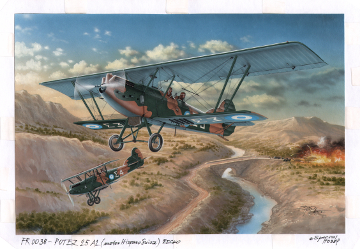
The first prototype (25.1) was transferred to S.T.Aé in 1925 for testing, whilst an unarmed prototype (25.2) made a tour of European countries to demonstrate the viability of the design. This indicated the need for some modifications, the most significant being an increase of the wingspan to 14.14 m.
The Potez 25 was one of the most widely built French aircraft between the World Wars. Most aircraft were powered by Lorraine 12 Eb, Hispano-Suiza, or Gnome-Rhône (a licence-built Bristol Jupiter) engines, whilst some used Renault, Farman, or Salmson power. Either Potez or Messier landing gear was fitted and three styles of tailfins employed. This very versatile design was operated by about 20 countries and was still in use at the outbreak of WWII.
The Hispano-Suiza powered Potez 25 A2/B2 was used by Abyssinia (3), Greece (30), Rumania (12), Switzerland (5), Uruguay (1), Yugoslavia (10), France (Ministry Transport Squadron).
In 1925 Potez granted a licence to build 300 Potez 25 with Jupiter to Yugoslavia and sold ten Hispano and thirty Lorraine powered aircraft to meet an urgent requirement. These were still in use until 1941, although some Hispano and Lorraine powered planes were re-engined with Jupiters. Some of these aircraft were then used by the Croats.
In 1927 Switzerland bought six Jupiter-powered Potez 25 A2 (851 to 854, 859 and 860) and four A2 aircraft fitted with Hispano-Suiza HS-50 12 Gb engines delivering 500 ch (855 to 858), a fifth Hispano-powered plane (853) was added into service in 1931. These aircraft were modified during their service with an increase in tailfin area to 2.44 m. The Potez 25 served with the Swiss Flieger-Abteilung II until 1940.
In 1927, Rumania began building hundreds of Lorraine-powered Potez 25 under licence, and in 1928 they bought 12 Potez Hispano-powered examples (Hispano 12 HB of 500 ch). These aircraft could easily be altered between biplane or monoplane configuration. Three Hispano-powered Potez 25 participated in the “Little Entente” and Poland competition held in Czechoslovakia in August 1928.
In 1930, Greece ordered thirty Potez 25 A2 fitted with Hispano-Suiza 12 Jb engine delivering 450 ch, these aircraft are thought to have been delivered in 1931. They were coded as Sigma 1 to 30. Unfortunately, these planes flew combat missions during the 1935 coup d’état. Seventeen were still in use when Italy attacked Greece in October 1940, and served until Greece’s defeat following German intervention in April 1941. Although obsolete by 1940, they adopted camouflage and were used for reconnaissance missions because more modern aircraft were not available.
Specifications (1929): Two-seat single-engined biplane for reconnaissance (A2) or bombing (B2). Engine: Hispano-Suiza 12 Gb giving 500 CV. Wingspan 14.14 m, length 9.20 m. Maximum speed: 230 km/h, ceiling 7,300 m, maximum weight 2,500 kg. Weapons: 1 fixed Vickers machine-gun, 2 Lewis machine-guns on TO7 mount, 1 Lewis machine-gun under belly. Bomb load (B2): up to 400 kg.
Documentation :
- Potez 25, collectif, Lela Presse (in french, 256 pages)
- IAR-Potez 25, Supplement Modelist n°1, Dan Antoniu and George Cicos, Rumanian and English
- L'Aviation Française en Indochine, 1910-1945, M. Ledet, C. Cony, L. Morareau, Lela Presse (in french, 640 p)
Camouflages:
- Camo A: Potez 25 B2, Royal Hellenic Air Force, coded Sigma 3. The starboard wing has not been camouflaged or was taken from another aircraft. Captured with five other planes (including Sigma 2, 5 and 6). Athenes-Tatoï airfield, end of April or May 1941
- Camo B: Potez 25 A2, Royal Rumanian Air Force. Engaged in the "Little Entente and Poland" aerial competition in 1928. Pilot Cap Gheorghe Ceausu, observer Cap Adrian Casolteanu, 6 th place. Prague, August 1928
- Camo C: :Potez 25 A2, Royal Rumanian Air Force, fist Hispano Potez delivered to Rumania in 1928, in monoplane configuration (it required only 15 mn to go from biplane to monoplane). Engaged in the "Little Entente and Poland" aerial competition in 1928. Pilot Lt Gheorghe Stefanescu, observer Lt-Col Stefan Protopopescu, finished 4 th. Prague, August 1928.
- Camo D: Potez 25, Yugoslav Army,. Also engaged in the "Little Entente and Poland" aerial competition in 1928. White 1 was a temporary number in use during the competition. Pilot Cne Hinko Hubl, observer Lt Miodrag Loyik, not qualified. Prague, August 1928.
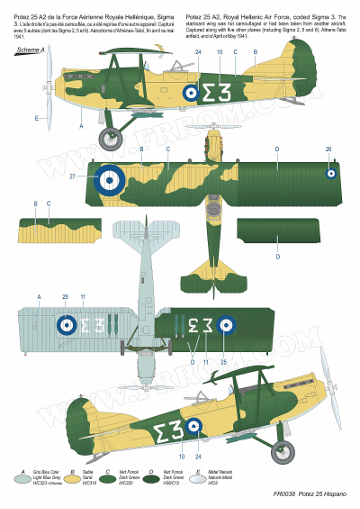
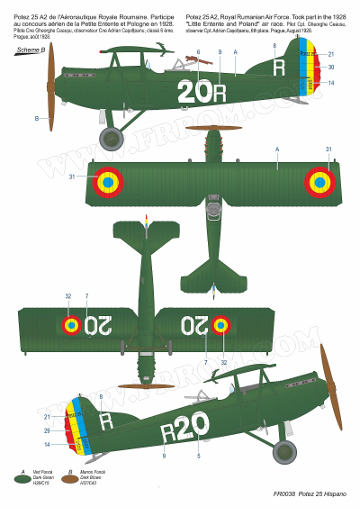
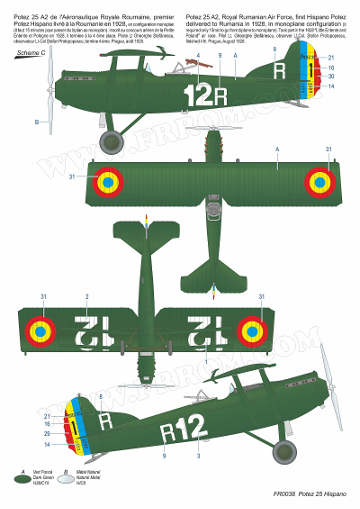
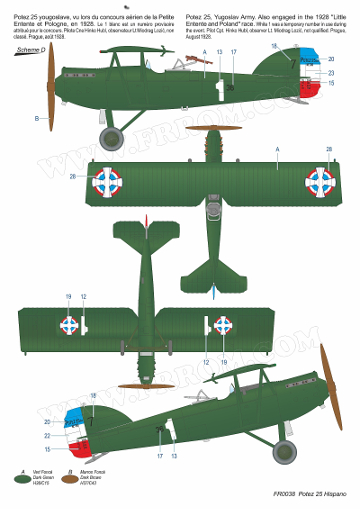
3D views (with Lorraine engine) :
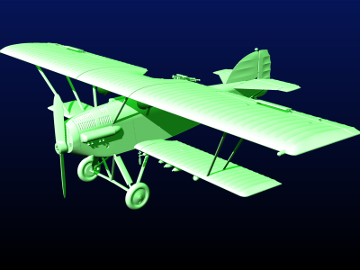

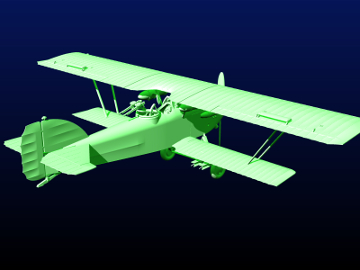




Documentation :
- Potez 25, Lela authors, Lela Presse (in french)